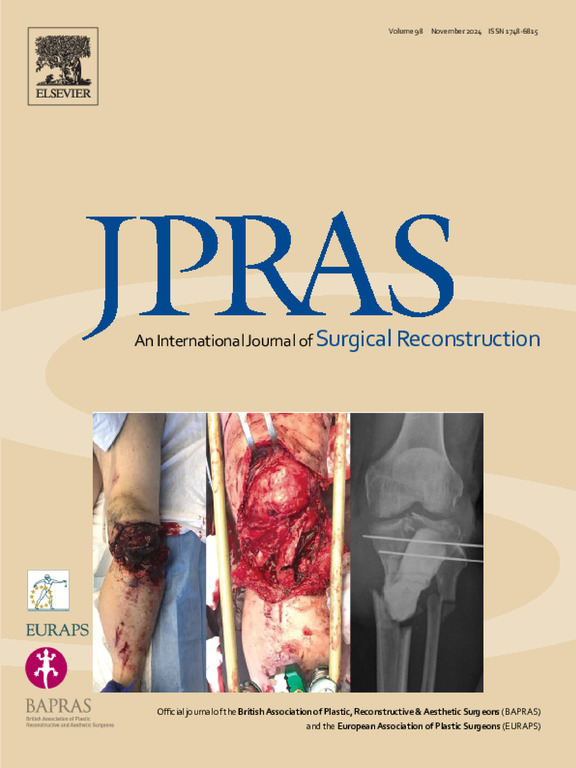Adipose-derived exosomes as a preventative strategy against complications in hyaluronic acid filler applications: A comprehensive in vivo analysis
IF 2
3区 医学
Q2 SURGERY
Journal of Plastic Reconstructive and Aesthetic Surgery
Pub Date : 2025-03-01
DOI:10.1016/j.bjps.2024.07.071
引用次数: 0
Abstract
Background
The aim of this study was to investigate the impact of exosomes derived from adipose-derived stem cells (ASCs) on complications arising from hyaluronic acid (HA) filler injections.
Methods
An HA hydrogel blended with adipose stem cell-derived exosomes was prepared and administered to the inguinal fat pads of 16 C57BL/6J mice. The control group received only HA filler (HA group), and the study group was treated with a combination of HA filler and exosomes (exoHA group). Biopsy was performed 1 week and 1, 2, 3, and 6 months after the injections. The effects were assessed using hematoxylin and eosin and Masson’s trichrome staining for histological examination, immunohistochemistry for collagen type I and Vascular Endothelial Growth Factor (VEGF), RNA sequencing, and quantitative real-time polymerase chain reaction (PCR) (Il6, Ifng, Hif1a, Acta2, Col1a1).
Results
RNA sequencing revealed significant downregulation of the hypoxia (false discovery rate [FDR] q = 0.007), inflammatory response (FDR q = 0.009), TNFα signaling via NFκB (FDR q = 0.007), and IL6 JAK-STAT signaling (FDR q = 0.009) gene sets in the exoHA group. Quantitative PCR demonstrated a decrease in expression of proinflammatory cytokines (Il6, P < 0.05; Hif1a, P < 0.05) and fibrosis markers (Acta2, P < 0.05; Col1a1, P < 0.05) within the exoHA group, indicating reduced inflammation and fibrosis. Compared to the exoHA group, the HA group exhibited a thicker and more irregular capsules surrounding the HA filler after 6 months.
Conclusion
The addition of ASC-derived exosomes to HA fillers significantly reduces inflammation and accelerates collagen capsule maturation, indicating a promising strategy to mitigate the formation of HA filler-related nodules.
脂肪源性外泌体作为一种预防透明质酸填充剂应用并发症的策略:体内综合分析。
背景:本研究旨在探讨脂肪源性干细胞(ASCs)提取的外泌体对透明质酸(HA)填充注射并发症的影响:本研究旨在探讨脂肪干细胞衍生的外泌体对透明质酸(HA)填充剂注射引起的并发症的影响:方法:制备混有脂肪干细胞衍生外泌体的HA水凝胶,并将其注射到16只C57BL/6J小鼠的腹股沟脂肪垫。对照组只接受HA填充物(HA组),研究组则接受HA填充物和外泌体的组合治疗(exoHA组)。分别在注射后 1 周、1、2、3 和 6 个月进行活组织检查。使用苏木精、伊红和马森三色染色法进行组织学检查、I型胶原蛋白和血管内皮生长因子(VEGF)免疫组化、RNA测序和定量实时聚合酶链反应(PCR)(Il6、Ifng、Hif1a、Acta2、Col1a1)评估效果:结果:RNA测序显示,在exoHA组中,缺氧(假发现率[FDR] q = 0.007)、炎症反应(FDR q = 0.009)、通过NFκB的TNFα信号转导(FDR q = 0.007)和IL6 JAK-STAT信号转导(FDR q = 0.009)基因组明显下调。定量 PCR 显示促炎细胞因子(Il6、P 结论)的表达有所下降:在 HA 填充物中添加源自 ASC 的外泌体可明显减轻炎症反应并加速胶原囊成熟,这表明这是一种很有前景的策略,可减轻 HA 填充物相关结节的形成。
本文章由计算机程序翻译,如有差异,请以英文原文为准。
求助全文
约1分钟内获得全文
求助全文
来源期刊
CiteScore
3.10
自引率
11.10%
发文量
578
审稿时长
3.5 months
期刊介绍:
JPRAS An International Journal of Surgical Reconstruction is one of the world''s leading international journals, covering all the reconstructive and aesthetic aspects of plastic surgery.
The journal presents the latest surgical procedures with audit and outcome studies of new and established techniques in plastic surgery including: cleft lip and palate and other heads and neck surgery, hand surgery, lower limb trauma, burns, skin cancer, breast surgery and aesthetic surgery.

 求助内容:
求助内容: 应助结果提醒方式:
应助结果提醒方式:


